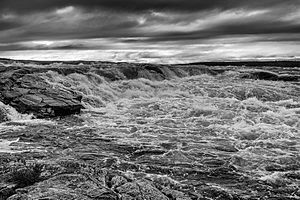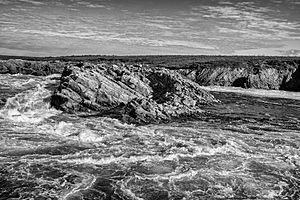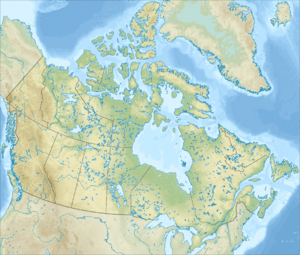Kazan River facts for kids
Quick facts for kids Kazan River |
|
|---|---|

Kazan Falls, on the lower Kazan River, July 2004
|
|
|
Kazan River mouth location
|
|
| Country | Canada |
| Physical characteristics | |
| Main source | Kasba Lake Northwest Territories 60°34′22″N 102°08′47″W / 60.57278°N 102.14639°W |
| River mouth | Baker Lake near Chesterfield Inlet, Kivalliq Region, Nunavut 64°2′30″N 95°29′5″W / 64.04167°N 95.48472°W |
| Length | 1,000 km (620 mi) |
| Basin features | |
| Basin size | 71,500 km2 (27,600 sq mi) |
The Kazan River is a special river in Nunavut, Canada. Its name in Inuktitut is Harvaqtuuq, which means "strong rapids" or "place of much fast flowing water." The Dene people, another Indigenous group, called it Kasba-tue, meaning "white partridge river." The name changed to Kazan in the late 1800s.
This amazing river starts in northern Saskatchewan at Kasba Lake. It then flows north for about 1,000 kilometers (621 miles). Finally, it empties into Baker Lake. Along its journey, the Kazan River passes through several lakes, like Ennadai Lake and Yathkyed Lake. It also goes over the beautiful Kazan Falls, which are 25 meters (82 feet) high! The river flows through a red sandstone gorge and different types of land, from boreal forests to wide open tundra. The part of the river below Ennadai Lake is especially important. It's above the tree line (where trees can't grow) and is named a Canadian Heritage River.
Contents
Amazing Animals and Plants Along the River

The Kazan River is famous for its incredible wildlife. The most well-known animals here are the barren-ground caribou. Over 300,000 caribou from the Qamanirjuaq and Beverly herds travel through this area. This is one of the biggest migrations of any land animal on Earth!
Besides caribou, you might also spot other cool animals. These include muskox, wolverine, and peregrine falcon. Many different kinds of fish also live in the river's waters.
A Look Back: History of the Kazan River

For about 5,000 years, the Kazan River has been important to people. The Caribou Inuit and the Chipewyan Sayisi Dene people were attracted to the area. They came because of all the wildlife available for hunting and fishing.
Originally, the Caribou Inuit would spend winters closer to the coast. But in the 1700s, the Dene used the area less. So, Caribou Inuit groups, like the Harvaqtuurmiut and Ihalmiut bands, started living along the river all year. You can still find signs of their old campsites along the river today. Even though Inuit people don't live along the river full-time anymore, they still visit to hunt and fish.
The first European to see this area was Samuel Hearne in 1770, at Yathkyed Lake. However, the river wasn't fully mapped until Joseph Tyrrell, a Canadian geologist, explored it in 1894. Another famous explorer, Knud Rasmussen, also visited the area between 1921 and 1924 during his Fifth Thule Expedition.
Fun on the River: Recreation
Today, the Kazan River is a popular spot for outdoor adventures. Many people enjoy kayaking and canoeing along its waters. It's a great way to experience the beautiful northern landscape and see some of the amazing wildlife up close.
See also
 In Spanish: Río Kazan para niños
In Spanish: Río Kazan para niños



